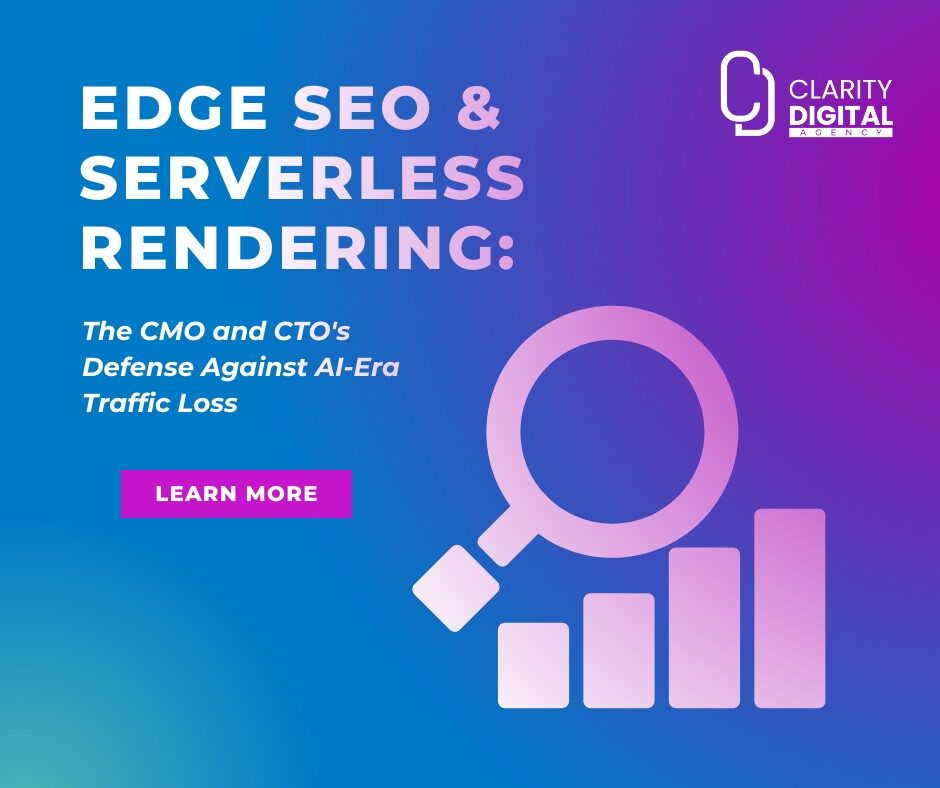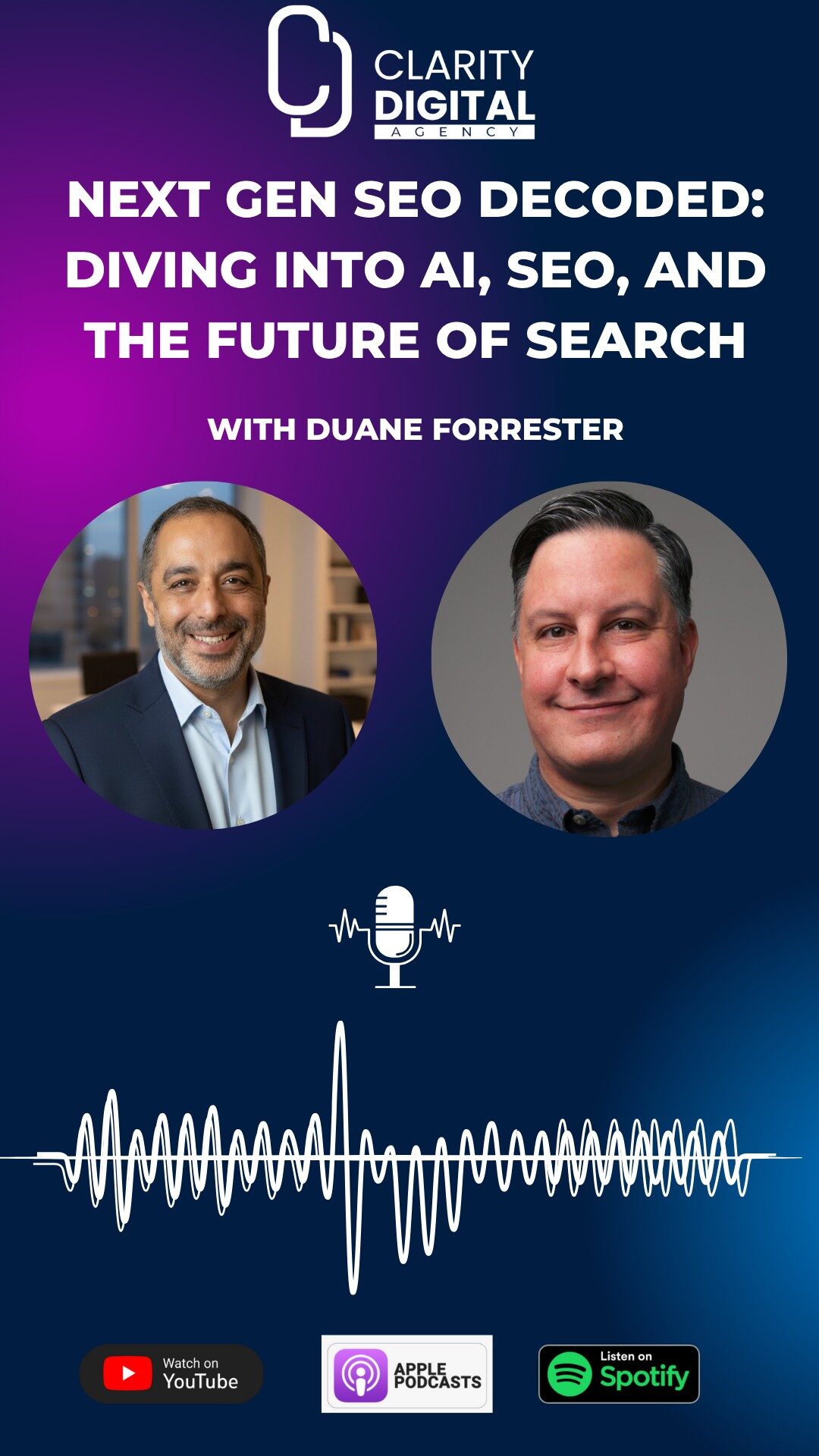Edge SEO is The CMO and CTO’s Defense Against AI-Era Traffic Loss
Edge SEO is the practice of executing SEO logic at the edge of a content delivery network (CDN), using serverless code to deliver faster, optimized pages. It matters in 2025 because AI crawlers now account for over 50% of web traffic, and noticeable page speed improvement can drive up to an 10% lift in conversion rates for retail sites. Serverless rendering and edgeworkers help large sites reduce load times, protect traffic, and future-proof organic performance.
Executive Introduction: Edge SEO is the Joint Growth Lever for CMOs and CTOs
The era of AI search is here. Over 50 billion AI crawler requests hit the web every day[1]. Generative search experiences from Google and OpenAI are pulling answers directly from your site—often without attribution or traffic.
This shift puts organic revenue at risk. Your fastest pages are your highest-converting ones. According to Google, improving page speed by just 0.1 seconds can boost conversions by 8.4%[2].
But here’s the problem: most enterprise SEO fixes move at a crawl. Dev queues are backlogged. CMS platforms are locked down. Code freezes derail launches.
Edge SEO and serverless rendering solve this. They let CMOs and CTOs jointly deploy technical SEO fixes fast. No deploys. No delays. Just results.
Let’s walk through why this matters and how to act.
What Is Edge SEO?
Edge SEO is the practice of applying SEO logic at the network edge—typically via serverless code executed on a CDN like Cloudflare or Fastly.
Coined by Dan Taylor,[3] the term reflects a strategic shift: from centralized SEO logic in the origin server to decentralized optimizations across global edge nodes.
This includes:
- Injecting meta tags on the fly
- Rewriting URLs or headers at the CDN level
- Serving pre-rendered HTML to bots
Because the logic runs at the edge, changes deploy instantly. No code push. No platform upgrade.
Edgeworkers (like Cloudflare Workers) make it possible. They execute JavaScript at the network perimeter—milliseconds from the user.
Think of it as SEO without waiting on IT.
Why CMOs and CTOs Should Care about Edge SEO
Edge SEO isn’t a technical curiosity. It’s a strategic, revenue-critical advantage for CMOs and CTOs alike—defending organic reach, accelerating performance, and turning infrastructure decisions into measurable growth.
More importantly, it highlights why these two roles must work in lockstep. The CMO brings urgency, metrics, and market awareness. The CTO provides the systems, security, and scalability. Edge SEO and serverless rendering sit squarely at their intersection—where digital performance meets business growth. When these leaders align, technical SEO no longer waits behind deployments. It becomes a proactive growth lever.
1. Traffic Cannibalization from AI Search
AI-generated answers are now surfacing directly in search results, bypassing traditional link clicks. Google SGE and ChatGPT pull summaries from your site—but don’t always send traffic back.
If your site isn’t optimized for AI crawlers, you risk losing visibility altogether. These bots prioritize structured, lightweight, and fast-loading content—precisely what edge SEO enables.
Imperva reports that AI crawlers now generate more than 51% of all web traffic[1].
CMOs and CTOs must understand: this isn’t a visibility dip—it’s an existential SEO shift.*
2. Performance Drives Conversion
Speed isn’t a UX detail—it’s a business multiplier. The faster your page loads, the more likely a visitor is to stay, engage, and convert.
Google data shows a 0.1-second improvement yields an 8.4% lift in CVR for retail[2].
Edge rendering shaves time off TTFB. It delivers pre-optimized content from the closest node, improving Core Web Vitals like LCP and INP.
For revenue teams, this means faster page speeds translate into better rankings, lower bounce rates, and higher ROI—without touching backend code.*
Edge rendering cuts load times. It improves Core Web Vitals. It protects bottom-line metrics.
3. Governance and Risk Management
Traditional SEO fixes rely on engineering sprints. But when timelines stretch across quarters, business risk increases. CMOs can’t act on SEO insights, and CTOs face growing security and compliance demands.
Edge SEO bridges this gap. With serverless logic, teams can:
- Deploy GDPR- or CCPA-compliant updates without backend disruption
- Block or allow bot traffic at the edge
- Quickly react to algorithm updates or compliance audits
This ensures technical SEO decisions align with governance, security, and real-time needs.
How Edge SEO Functions Clear the Technical Backlog
Enterprise SEO bottlenecks are real. Here’s how Edgeworkers break them:
Modify SEO Elements Without Deploys
With Edgeworkers, your teams can:
- Add or override meta tags
- Manage redirects
- Inject hreflang and canonical tags
All in real-time.
Real-World Example
A major ecommerce brand faced a critical site migration involving hundreds of URLs. Their SEO team flagged the need for immediate 301 redirects to preserve link equity and avoid traffic loss.
However, DevOps resources were tied up in a quarterly release cycle. The estimated timeline? Six weeks—and over $30,000 in engineering time just to write, test, and deploy the redirect logic through the core application.
Instead, the SEO and platform teams collaborated and turned to Cloudflare Workers. In less than an hour, they wrote a lightweight serverless script at the edge that performed all 301 redirects with zero deployment to the origin server.
More about this on the Cloudflare Workers SEO documentation.
The results:
- No deploys or rollback risks
- No code freeze delays
- Full redirect coverage across global edge nodes
What was once a costly engineering sprint became a same-day SEO fix—with no tradeoffs to security or scalability.
No backlog. No friction. Just business-critical SEO execution at speed.
Serverless Rendering for JS-Heavy Sites
Modern SPAs (Single Page Applications) are great for users—but not for search engines. They rely heavily on JavaScript to render content, which many crawlers struggle to process. The result? Incomplete indexing, missed content, and degraded organic visibility.
Serverless rendering addresses this challenge by generating static HTML at the network edge before it reaches the client or crawler. This means bots receive fully rendered content instantly, while human users still benefit from full JavaScript interactivity post-load.
The key advantage is that serverless rendering happens outside your core infrastructure. It avoids taxing the origin server and speeds up response times—improving both crawl efficiency and user experience.
Case Study: LinkedIn’s Rendering Efficiency
LinkedIn deployed edge-based pre-rendering for dynamic sections of their site that were previously hard to crawl.
The outcome:
- Crawl efficiency improved significantly, enabling search engines to process more pages in less time.
- Indexed pages increased as content that was once hidden behind scripts became fully visible to bots.
- Organic sessions rose—thanks to better discoverability and faster load speeds across markets.
As detailed in a LinkedIn engineering blog.
For CMOs and CTOs, this proves the business case: serverless rendering at the edge transforms SEO from a blocker into a strategic advantage—especially on modern JavaScript frameworks.
Edge rendering bridges the gap between modern UX expectations and the structured content visibility that search engines demand.
Edge rendering bridges the gap between modern UX and crawler needs.
Edge SEO is performance SEO. In the AI-first search era, every millisecond of latency is a lost opportunity to convert, rank, or retain.
TTFB and Core Web Vitals
By serving pages from edge nodes closest to the user, Edge SEO significantly reduces Time to First Byte (TTFB). This early metric sets the tone for the rest of the page load experience and directly influences Google’s Core Web Vitals.
Here’s what improves as TTFB drops:
- Largest Contentful Paint (LCP): Measures when the main content becomes visible. A faster TTFB accelerates this, enhancing perceived speed.
- Interaction to Next Paint (INP): The new metric replacing FID in 2024, INP gauges responsiveness to user input. Lower TTFB helps front-load scripts and reduce delay.
Cloudflare found edge-rendered pages reduced TTFB by 35% on average[4].
These metrics not only impact user experience but also influence search engine rankings. Google has explicitly tied Core Web Vitals to SEO performance signals.
Conversion Follows Performance
Every second—or fraction thereof—counts. Faster loading pages reduce bounce rates and increase the chance that a visitor becomes a lead or a buyer.
- A smoother UX increases engagement and lowers abandonment.
- Improved Core Web Vitals lead to better rankings in competitive SERPs.
- Pages that load instantly convert more efficiently, especially on mobile and ecommerce flows.
Edge SEO transforms performance wins into measurable business results. It shortens the path between technical improvements and revenue outcomes—something both CMOs and CTOs are under pressure to deliver.
In short: Edge performance = faster pages = higher visibility = more revenue.
AI bots are scraping. A lot. And they’re not going away. With the rise of generative search platforms like ChatGPT and Google’s SGE, AI crawlers are increasingly consuming, summarizing, and representing your content to users—often without sending traffic in return.
Cloudflare now gives organizations the ability to segment bot categories. This allows CTOs and platform leads to:
- Throttle or block unwanted AI crawlers based on behavior and intent
- Apply custom logic at the edge using Workers to serve alternate content or deny access
- Monitor and log LLM access to sensitive sections of the site
Cloudflare introduced AI bot management in 2023[5].
This isn’t just a technical issue—it’s a strategic one. CMOs and CTOs must work together to:
- Reduce wasted infrastructure spend from unmonetized bot traffic
- Determine which pages are safe (or valuable) to allow into AI training sets
- Safeguard how brand content is interpreted, summarized, or misrepresented by LLMs
Imperva estimates that bad bots consume over 30% of bandwidth[1].
Edge SEO brings control back to the enterprise. With proper governance, you can tailor access for bots the same way you tailor experiences for users. It’s not enough to optimize for Google anymore—you must optimize for the machines that power the machines.
Manage them. Don’t feed them blindly.
90-Day Edge SEO Implementation Roadmap
| Phase | Timeline | Key Actions |
|---|---|---|
| Audit | Weeks 1–2 | – Run crawl diagnostics- Identify slow pages, bot traps |
| Proof of Concept | Weeks 3–8 | – Deploy edge worker on key section- Test TTFB & indexing |
| Full Rollout | Weeks 9–12 | – Expand to all templates- Automate meta/hreflang updates |
Capex/Opex Comparison
Edge SEO dramatically shifts the cost structure of technical SEO operations—from high-cost, high-latency engineering work to agile, serverless deployment models.
- No server cost: Serverless infrastructure means you don’t need to maintain dedicated hardware or scale origin servers for SEO changes. CDN-based execution is usage-based, not capacity-based—reducing infrastructure expenses.
- No dev cycles: SEO changes at the edge bypass the traditional release pipeline. This eliminates the need to allocate developer sprints for minor updates like redirects, tag fixes, or bot directives.
- Lower total cost of ownership (TCO): When you combine fewer engineering hours, faster time to deployment, and improved performance metrics, edge SEO significantly lowers the long-term cost of maintaining SEO readiness.
For CTOs, this means optimized resource allocation. For CMOs, it means faster time-to-impact on organic revenue.
Edge SEO is lean, fast, and scalable.
Measuring Impact: From SEO Change to Pipeline
Track the full chain of outcomes to demonstrate ROI at every level of execution. Edge SEO isn’t just a technical enhancement—it’s a measurable growth engine.
Edge change → CWV uplift → crawl efficiency → sessions → leads → revenue- Edge change: You implement a technical improvement at the CDN layer—such as faster redirects, improved tagging, or serverless rendering.
- CWV uplift: That change improves Core Web Vitals like TTFB, LCP, and INP.
- Crawl efficiency: Better performance leads to deeper and more frequent bot crawling, increasing your content’s discoverability.
- Sessions: As more pages are indexed and load faster, organic traffic increases.
- Leads: Higher engagement from better UX drives more conversions.
- Revenue: Those leads move into your pipeline, translating SEO gains directly into dollars.
This full-funnel path makes Edge SEO uniquely trackable and attributable. CMOs can link SEO work to pipeline growth. CTOs can validate the infrastructure impact. Together, they gain clarity on how technical execution fuels business results.
Simple Forecast Table
| Metric | Pre-Edge | Post-Edge | Uplift |
|---|---|---|---|
| TTFB | 780ms | 410ms | -47% |
| LCP | 3.2s | 2.1s | -34% |
| Indexed URLs | 220k | 295k | +34% |
| Organic Sessions | 1.4M/mo | 1.9M/mo | +35% |
| Est. Pipeline Impact | $2.8M/qtr | $3.8M/qtr | +$1M |
Use this framework to build your business case.
Common Pitfalls & How to Avoid Them
Edge SEO is powerful, but not foolproof. As CMOs and CTOs roll out edge-based solutions, these common errors can undermine even the most well-intentioned strategy.
1. Cache-Bypass Errors
Caching is essential for performance—but edge rules can accidentally bypass or misconfigure headers. This leads to longer TTFB and higher server load. Ensure edge logic respects caching standards. Always test for CDN cache hits and misses.
Pro tip: Use tools like Cloudflare’s analytics dashboard to monitor cache efficiency.
2. Duplicate Headers
When injecting metadata at the edge, it’s easy to create duplication. Titles, canonical tags, or hreflang elements added on top of origin output confuse crawlers. Search engines may skip indexing or assign ranking signals incorrectly.
Best practice: Run validation crawls post-deployment. Use Screaming Frog or Sitebulb to detect duplicated elements.
3. Security Leaks
Because edge functions operate outside the origin server, they can unintentionally expose sensitive logic or data. URL rewrites, API keys, and internal redirects should never be visible in source or headers.
Action step: Sanitize and obfuscate any exposed paths. Implement input validation and monitor for unusual bot activity.
Always have a seasoned technical SEO or edge platform specialist review any code shipped to the CDN layer. Even small oversights can cascade into significant visibility, security, or performance problems.Final SEO Takeaways for CMOs and CTOs Navigating the AI Era
Avoid common deployment pitfalls. Misconfigured cache rules, duplicated headers, or unsecured logic can undermine performance and indexation
Edge SEO enables instant, scalable optimization at the CDN level. It removes bottlenecks from dev queues and allows SEO changes—like redirects, canonicals, or headers—to deploy in real time.
AI bots now dominate traffic and require strategic oversight. With over 51% of traffic coming from bots, managing what’s served to AI crawlers is critical to protecting organic visibility.
Speed is directly linked to revenue. Even a 0.1-second load time improvement can boost conversions by 8.4%. Edge rendering improves Core Web Vitals and shortens TTFB.
Edge SEO clears technical SEO backlogs without code freezes. CMOs and CTOs can work together to push fixes without touching the backend—accelerating time-to-impact.
Serverless rendering improves crawlability for JavaScript-heavy sites. SPAs often confuse bots. Pre-rendering HTML at the edge solves discoverability without compromising UX.
Bot governance is essential in an AI-first search world. Platforms like Cloudflare give teams the ability to throttle or segment AI crawlers, balancing visibility with cost control.
Start lean with a phased 90-day roadmap. Begin with an audit, test a proof of concept, and then scale across templates—keeping risk and cost low.
INP and TTFB are the new leading indicators for SEO performance. These Core Web Vitals now influence both ranking and UX; edge delivery helps teams stay ahead.
Track results from code to revenue. Tie each edge SEO improvement to Core Web Vitals, indexed pages, and pipeline growth.
Ready to assess your site’s readiness for the AI-crawled era? Clarity Digital offers a tailored AI-era SEO audit to help CMOs and CTOs identify gaps, deploy edge SEO solutions, and protect pipeline performance.
Citations:
1] The Independent, Imperva Bot Report
[2] Google Business, Think With Google Study
[3] Search Engine Land, Edge SEO Primer
[4] The Cloudflare Blog, Core Web Vitals Update
[5] The Cloudflare Blog, AI Bot Categories Announcement





